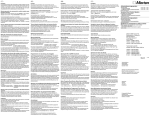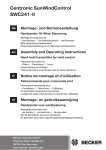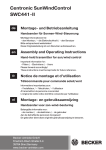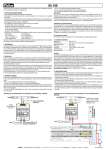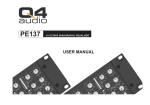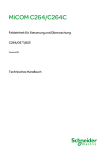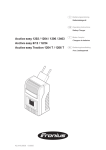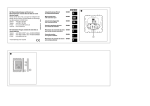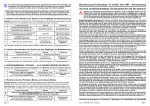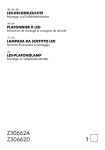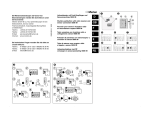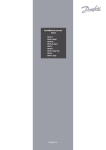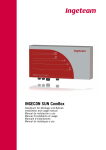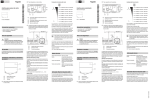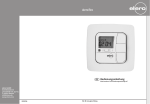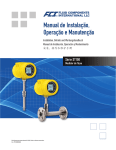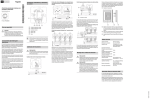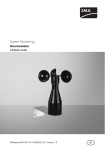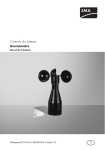Download D GB NL E F P © © @ ©
Transcript
Bei Warenrücksendungen auf Grund von Beanstandungen wenden Sie sich bitte an unser Service Center: Merten GmbH & Co. KG, Lösungen für intelligente Gebäude, Service Center, Fritz-Kotz-Straße 8, Industriegebiet Bomig-West, D-51674 Wiehl Telefon: +49 2261 702-204 Telefax: +49 2261 702-136 E-Mail: [email protected] Internet: www.merten.de V5806-585-00 01/07 5806_585_00_Umschlag.fm Seite 1 Freitag, 26. Januar 2007 11:42 11 Bei technischen Fragen wenden Sie sich bitte an unsere InfoLine: Telefon: +49 1805 212581* oder +49 800 63783640 Telefax: +49 1805 212582* oder +49 800 63783630 E-Mail: [email protected] Windsensorschnittstelle 580693 Wind sensor interface 580693 Windsensor-interface 580693 Interface para sensor de viento 580693 Interface du capteur de vent 580693 Windsensorschnittstelle 580693 *kostenpflichtig / fee required 5806_585_00_Umschlag.fm Seite 2 Freitag, 26. Januar 2007 11:42 11 „ $ 0 L N - + 1 2 4 Sensor 0 => 10 Bft (~ 24,5 m/s = 88 km/h) 3 1 9 => 9 Bft (~ 20,8 m/s = 75 km/h) 8 => 8 Bft (~ 17,2 m/s = 62 km/h) 2 7 => 7 Bft (~ 14,1 m/s = 51 km/h) § L AC 230 V N 6 => 6 Bft (~ 11,0 m/s = 40 km/h) 5 => 5 Bft (~ 8,0 m/s = 29 km/h) 4 => 4 Bft (~ 5,5 m/s = 20 km/h) L N - +12 Motor 1 2N L M 3 => 3 Bft (~ 3,3 m/s = 12 km/h) ! D 3 GB NL E F P 2 2 1 V5806-585-00.book Seite 1 Freitag, 26. Januar 2007 11:40 11 V5806-585-00.book Seite 2 Freitag, 26. Januar 2007 11:40 11 ¼ Das können Sie mit der Windüberwachung tun D Gebrauchsanweisung 2 Operating instructions 10 GB Die Windüberwachung ermöglicht das Auffahren der Jalousie in Abhängigkeit der Windstärke. Die Auf-Position schützt empfindliche Jalousielamellen und sorgt dadurch für Sicherheit bei aufkommendem Wind. Gebruiksaanwijzing 18 NL Die Windüberwachung besteht aus 2 Komponenten: Instrucciones de servicio 29 E Notice d'utilisation 34 F Instruções de serviço 42 P I V5806-585-00.book Seite 4 Freitag, 26. Januar 2007 11:40 11 Zum Anschluß des Windsensors abgeschirmte Leitung (Empfehlung JY-ST-Y 2x2x0,6) verwenden. Die Leitung darf nicht gemeinsam mit 230 V-Leitungen verlegt werden (Gefahr der Einkopplung von Störungen). Annschluss Windsensor-Schnittstelle Die Windsensor-Schnittstelle ermöglicht die Ankopplung des Windsensors an den Jalousiesteuerungs-Einsatz. 1. Deckel des Anschlußgehäuses (Bild !1) nach Lösen beider Schrauben (Bild !2)‚ entfernen. (Bei rückseitiger Leitungseinführung Gummitülle (Bild „2) durchstoßen und Leitung einführen). 2. Gerät mit 2 Schrauben befestigen. 3. Leitungen ins Anschlußgehäuse einführen und gemäß Bild § anschließen. 4 V5806-585-00.book Seite 3 Freitag, 26. Januar 2007 11:40 11 Lebensgefahr durch elektrischen Strom. Das Gerät darf nur von Elektrofachkräften montiert und angeschlossen werden. Beachten Sie die länderspezifischen Vorschriften. | Alle benötigten Schrauben und Dübel sind im LieInstallationshinweise ferumfang enthalten. Montage Windsensor, Windsensor mit Heizung • einem Windsensor (Art. Nr. 580692) oder Windsensor mit Heizung (Art. Nr. 580690) und • der Windsensor-Schnittstelle (Bild !). Der Windsensor wird in Verbindung mit dem Jalousiesteuerungs-Einsatz, bzw. mit den Binäreingängen des KNX-Systemes betrieben. Der Windsensor (Art. Nr. 580692) bzw der Windsensor mit Heizung (Art. Nr. 580690) wird auf dem Dach oder an der Hauswand montiert. Er muß an einer für die Windstärkemessung günstigen Position angebracht werden. Nicht im Windschatten montieren. Auf lagerichtige Anbringung achten. 2 3 V5806-585-00.book Seite 5 Freitag, 26. Januar 2007 11:40 11 Die Windsensor-Schnittstelle ist mit potentialfreien Schließern bestückt. Zur Verwendung auf gleicher Phase Brücke zwischen L und K entsprechend Bild § installieren. Bei Anschluß von Niederspannungskreisen am potentialfreien Schließer, Errichtungsbestimmungen nach VDE 0100 beachten. Wahl Windsensor. Es können 2 verschiedene Typen Windsensoren angeschlossen werden. Den Schalter (Bild „§) in die Position II bringen (Werkseinstellung). Wahl Testbetrieb / Windstärkeauswertung Mit dem Drehschalter (Bild „4) wird, je nach Stellung der 10 Position (1, 2, 3, ... 9, 0): • der Testbetrieb aktiviert (Position 1 und 2). • die Windstärke vorgegeben, bei der die Jalousie auffährt oder (Position 3 - 0) 5 V5806-585-00.book Seite 6 Freitag, 26. Januar 2007 11:40 11 Testbetrieb Die Positionen 1 oder 2 aktivieren den Testbetrieb: Nach max. 1 Sekunde leuchtet die optische Anzeige (TestLED, Bild !3) auf. Wird das Geberrad gedreht, flackert die Test-LED in der Frequenz der Drehgeschwindigkeit und die Funktion des Gerätes kann schon bei niedriger Umdrehungszahl des Geberrades geprüft werden. Windstärkeauswertung Mit der Position 3 - 0 wird die Windstärke selektiert, bei welcher die Jalousie aufgefahren wird. Die Einstellung erfolgt in Beaufort (Bft), siehe Bild §. Nach Verlassen des Testbetriebes vergehen ca. 4 Sekunden bis die eingestellte Windstärke vom Gerät ausgewertet wird. Nach dem Wechsel zwischen zwei Windstärkeeinstellungen wird die gewählte Einstellung nach max. 4,5 Minuten übernommen. 6 V5806-585-00.book Seite 7 Freitag, 26. Januar 2007 11:40 11 V5806-585-00.book Seite 8 Freitag, 26. Januar 2007 11:40 11 | Windstärkeauswertungen zu realisieren, zu- Um ein schnelles Umschalten zwischen zwei Technische Daten nächst Testbetrieb wählen und dann gewünschte Windstärke einstellen. Versorgungsspannung: 230 V AC, 50 Hz Ausgang: potentialfreier Kontakt zur Ansteuerung eines JalousiesteuerungsEinsatzes. Ansprechzeit: ca. 15 Sek. (nach Überschreiten der gewählten Windstärke) Nachlaufzeit: ca. 15 Min. (nach Unterschreiten der gewählten Windstärke) Die Klemmen 1und 2 dienen als Verteilerklemmen und sind geräteintern nicht beschaltet. Sie können z.B. für einen Windsensor mit Heizung verwendet werden. Die einzelne Verteilerklemme (Bild „1) dient zum Anschluß des Schutzleiters. Deckel des Gerätes schließen. 7 V5806-585-00.book Seite 10 Freitag, 26. Januar 2007 11:40 11 What you can do with the wind monitoring unit The wind monitoring unit enables the blinds to be raised or lowered depending on the wind strength. The Up position protects fragile blind slats, thereby maintaining safety in windy weather. 8 9 V5806-585-00.book Seite 11 Freitag, 26. Januar 2007 11:40 11 ¼ Risk of fatal injury from electrical current. The device may only be installed and connected by skilled electricians. Observe the countryspecific regulations. | The required screws and plugs are included with • a wind sensor (art. no. 580692) or a wind sensor with heating (art. no. 580690) and • the wind sensor interface (Figure !). 10 V5806-585-00.book Seite 12 Freitag, 26. Januar 2007 11:40 11 Use a shielded wire for the wind sensor connection (we suggest: JY-ST-Y 2x2x0.6). Do not lay the cable together with 230 V wires (risk of interference). Connecting the wind sensor interface Installation notes the delivery. The wind monitoring unit consists of two components: The wind sensor is operated in connection with the blind control insert and the binary inputs of the KNX system. V5806-585-00.book Seite 9 Freitag, 26. Januar 2007 11:40 11 Installing the wind sensor, wind sensor with heating The wind sensor (art. no. 580692) or the wind sensor with heating (art. no. 580690) is installed on the roof or the outside wall of the building. It must be mounted in a position suitable for measuring the wind strength. The device must therefore not be mounted in the slipstream of any objects. Ensure that the device is mounted in the correct position. 11 The wind sensor is connected to the blind control insert using the wind sensor interface. 1. Remove the lid of the connection housing (Figure !1) by removing the two screws (Figure !2). (If the cable entry is at the back, pierce through the rubber grommet (Figure „2) and insert the wire). 2. Secure the device using two screws. 3. Insert cables into the connection housing and connect them as shown in Figure §. The wind sensor interface is equipped with floating make contacts. For use at the same phase, install a bridge between L and K as per Figure §. When low12 V5806-585-00.book Seite 13 Freitag, 26. Januar 2007 11:40 11 voltage circuits are connected to the floating make contact, observe the VDE 0100 regulations. V5806-585-00.book Seite 14 Freitag, 26. Januar 2007 11:40 11 Test mode Selecting the wind sensor Two different types of wind sensors can be connected. Set the switch (Figure „§) to position II (factory setting). Selecting test mode / wind strength evaluation Moving the rotary switch (Figure „4) into one of the ten positions (1, 2, 3, ... 9, 0): • activates the test mode (positions 1 and 2). • defines the wind strength at which the blinds are raised (position 3 - 0). V5806-585-00.book Seite 15 Freitag, 26. Januar 2007 11:40 11 | strength evaluation to another, select the test In order to quickly switch over from one wind Positions 1 and 2 activate the test mode: The optical display (test LED, Figure !3) lights up after a maximum of one second. If the rotary sensor is rotated, the test LED flickers at the frequency of the rotational speed and one can test that the unit is working even when the rotational speed of the rotary sensor is low. Wind strength evaluation Position 3 - 0 defines the wind strength at which the blinds are raised. The setting is made in Beaufort (Bft) units, see Figure §. mode and then set the desired wind strength. Terminals 1 and 2 serve as distributor terminals and are not wired inside the unit. They can be used for a wind sensor with heating, for example. The individual distributor terminal (Figure „1) is used to connect the protective conductor. Close the lid of the unit. After exiting the test mode, it takes the unit about 4 seconds for the device to evaluate the set wind force. The selected setting will be applied after a maximum of 4.5 minutes after switching from one wind strength to another. 13 V5806-585-00.book Seite 16 Freitag, 26. Januar 2007 11:40 11 14 15 V5806-585-00.book Seite 17 Freitag, 26. Januar 2007 11:40 11 V5806-585-00.book Seite 18 Freitag, 26. Januar 2007 11:40 11 Technical data Mogelijkheden van de windbewaking Supply voltage: 230 V AC, 50 Hz Output: Floating contact for the control of a blind control insert. Response time: About 15 seconds (after exceeding the selected wind strength) De windbewaking bestaat uit twee componenten: About 15 minutes (after exceeding the selected wind strength) • de windsensor-interface (afbeelding !). Overshoot time: 16 De windbewaking maakt het mogelijk de jaloezie omhoog te laten gaan afhankelijk van de windsterkte. De omhoog-positie beschermt gevoelige jaloezielamellen en zorgt hierdoor voor veiligheid bij opkomende wind. • een windsensor (art.nr. 580692) of windsensor met verwarming (art.nr. 580690) en De windsensor wordt in combinatie met de jaloeziebesturingssokkel, resp. met de binaire ingangen van het KNX-systeem gebruikt. 17 18 V5806-585-00.book Seite 19 Freitag, 26. Januar 2007 11:40 11 ¼ Levensgevaar door elektrische stroom. Het apparaat mag uitsluitend door elektriciens gemonteerd en aangesloten worden. Neem de nationale voorschriften in acht. V5806-585-00.book Seite 20 Freitag, 26. Januar 2007 11:40 11 Voor aansluiting van de windsensor een afgeschermde leiding (aanbeveling JY-ST-Y 2x2x0,6) gebruiken. De leiding mag niet samen met 230 V-leidingen gelegd worden (gevaar voor koppeling van storingen). | Alle benodigde schroeven en pluggen worden Aanwijzingen voor de installatie Aansluiting windsensor-interface De windsensor-interface maakt de koppeling van de windsensor aan de jaloezie-besturingssokkel mogelijk. standaard meegeleverd. Montage windsensor, windsensor met verwarming De windsensor (art.nr. 580692) resp. de windsensor met verwarming (art.nr. 580690) wordt op het dak of aan de huisgevel gemonteerd. De sensor moet op een voor de meting van de windkracht gunstige plaats worden aangebracht. Niet in de luwte monteren. Zorg ervoor dat het apparaat in de juiste positie wordt aangebracht. 19 V5806-585-00.book Seite 22 Freitag, 26. Januar 2007 11:40 11 Testmodus Positie 1 of 2 activeert de testmodus: na max. 1 seconde gaat de optische indicatie (test-LED, afbeelding !3) branden. Als het sensorwiel wordt gedraaid, knippert de test-LED met de frequentie van de draaisnelheid en de functie van het apparaat kan al bij een lage omwentelingssnelheid van het sensorwiel worden gecontroleerd. Windsterkte-analyse Met de positie 3 - 0 wordt de windsterkte geselecteerd, waarbij de jaloezie omhoog wordt bewogen. De instelling vindt plaats in Beaufort (Bft), zie afbeelding §. 1. Deksel van de aansluitbehuizing (afbeelding !1) na het losdraaien van beide schroeven (afbeelding !2) verwijderen. (bij kabelinvoer aan de achterzijde de rubbertule (afbeelding „2) doordrukken en leiding invoeren). 2. Apparaat met 2 schroeven bevestigen. V5806-585-00.book Seite 21 Freitag, 26. Januar 2007 11:40 11 De windsensor-interface is uitgerust met potentiaalvrije maakcontacten. Voor gebruik met dezelfde fase brug tussen L en K volgens afbeelding § installeren. Bij aansluiting van laagspanningscircuits op het potentiaalvrije maakcontact, bepalingen conform VDE 0100 in acht nemen. Selecteer windsensor. Er kunnen 2 verschillende types windsensoren worden aangesloten. Breng de schakelaar (afbeelding „§) in positie II (fabrieksinstelling). Selecteer testmodus / windsterkte-analyse Met de draaischakelaar (afbeelding „4) wordt afhankelijk van de stand (1, 2, 3, ... 9, 0): • de testmodus geactiveerd (positie 1 en 2). 3. Leidingen in de aansluitbehuizing voeren en volgens afbeelding § aansluiten. • de windsterkte aangegeven, waarbij de jaloezie omhoog beweegt (positie 3 - 0) 20 21 V5806-585-00.book Seite 23 Freitag, 26. Januar 2007 11:40 11 V5806-585-00.book Seite 24 Freitag, 26. Januar 2007 11:40 11 windsterkte-instellingen wordt de geselecteerde instelling na max. 4,5 minuten overgenomen. Technische gegevens Voedingsspanning: 230 V AC, 50 Hz Uitgang: De klemmen 1 en 2 zijn bedoeld als verdeelklemmen en zijn apparaat-intern niet geschakeld. Ze kunnen bijv. voor een windsensor met verwarming worden gebruikt. potentiaalvrij contact voor aansturing van een jaloezie-besturingssokkel. Aanspreektijd: De afzonderlijke verdeelklem (afbeelding „1) is bedoeld voor aansluiting van de aardedraad. ca. 15 sec. (na overschrijding van de geselecteerde windsterkte) Nalooptijd: ca. 15 min. (na overschrijding van de geselecteerde windsterkte) | windsterkte-analyses te realiseren, dient u eerst Om een snelle omschakeling tussen twee de testmodus te selecteren en daarna de gewenste windsterkte in te stellen. Deksel van het apparaat sluiten. Na het verlaten van de testmodus gaan ca. 4 seconden voorbij tot de ingestelde windsterkte door het apparaat wordt geanalyseerd. Na het wisselen tussen twee 22 23 24 V5806-585-00.book Seite 25 Freitag, 26. Januar 2007 11:40 11 V5806-585-00.book Seite 26 Freitag, 26. Januar 2007 11:40 11 Utilidad de la vigilancia eólica La vigilancia eólica permite subir la persiana de lamas en función de la fuerza del viento. La posición de encendido protege las delicadas lamas de la persiana y ofrece seguridad en caso de que se levante un viento fuerte. V5806-585-00.book Seite 27 Freitag, 26. Januar 2007 11:40 11 ¼ Peligro de muerte por descarga eléctrica. El dispositivo sólo debe ser montado y conectado por electricistas debidamente cualificados. Tenga en cuenta la normativa específica del país. | Todos los tornillos y tacos necesarios para la Indicaciones para la instalación instalación están incluidos en el suministro. La vigilancia eólica consta de 2 componentes: Montaje del sensor de viento Sensor de viento con calefacción • un sensor de viento (ref. 580692) o un sensor de viento con calefacción (ref. 580690) y • una interface para sensor de viento (figura !). El sensor de viento (ref. 580692) o el sensor de viento con calefacción (ref. 580690) se monta en el techo o en una pared, debiendo colocarse en una posición en la que pueda medir la fuerza del viento. No lo monte a resguardo del viento. Es importante colocarlo en el lugar correcto. El sensor de viento funciona en combinación con el control de persianas de lamas o con las entradas binarias del sistema KNX. 25 V5806-585-00.book Seite 28 Freitag, 26. Januar 2007 11:40 11 Para conectar el sensor de viento, utilice un cable apantallado (sugerencia: JY-ST-Y 2x2x0,6). El cable no debe instalarse con cables de 230 V (peligro de acoplamiento de interferencias). Conexión de la interface para sensor de viento La interface para sensor de viento permite acoplar el sensor de viento al control de persianas de lamas. 1. Retire la tapa de la caja de unión (figura !1) aflojando los dos tornillos (figura !2). (En el caso de que el cable tenga la entrada por la parte trasera, perfore el revestimiento de goma (figura „2) e introduzca el cable). 2. Fije el aparato con dos tornillos. 3. Introduzca los cables en la caja de unión y conéctelos como se indica en la figura §. 28 26 27 V5806-585-00.book Seite 29 Freitag, 26. Januar 2007 11:40 11 La interface para sensor de viento está dotada de contactos n.a. libres de potencial. Para su empleo en la misma fase, instale un puente entre L y K como se ilustra en la figura §. Para conectar circuitos de baja tensión a los contactos n.a. libres de potencial, tenga en cuenta las normas VDE 0100. Elección del sensor de viento. Se pueden conectar 2 tipos diferentes de sensores de viento. Coloque el interruptor (figura „§) en la posición II (ajuste de fábrica). Elección del modo de test / evaluación de la fuerza del viento En función de la posición seleccionada (1, 2, 3, ... 9, 0), el conmutador (figura „4) permite: • activar el modo de test (posición 1 y 2) • especificar la fuerza del viento necesaria para que la persiana de lamas suba (posición 3 0) 29 V5806-585-00.book Seite 30 Freitag, 26. Januar 2007 11:40 11 Modo de test Las posiciones 1 y 2 activan el modo de test: El indicador óptico (LED de prueba, figura !3) se ilumina transcurrido un segundo como máximo. Al girar la rueda, el LED de prueba parpadea en la frecuencia de la velocidad a la que se gira el botón. El funcionamiento del aparato se puede comprobar incluso si la velocidad de giro de la rueda es baja. Evaluación de la fuerza del viento Las posiciones 3 - 0 permiten seleccionar la fuerza del viento necesaria para que la persiana de lamas suba. El ajuste se realiza en la escala de medida Beaufort (Bft), véase la figura §. Una vez que se ha salido del modo de test, transcurren aprox. 4 segundos hasta que el aparato evalúa la intensidad del viento seleccionada. Al cambiar entre dos ajustes de fuerza del viento, el nuevo ajuste 30 V5806-585-00.book Seite 31 Freitag, 26. Januar 2007 11:40 11 V5806-585-00.book Seite 32 Freitag, 26. Januar 2007 11:40 11 seleccionado se aplica transcurrido un máx. de 4,5 minutos. V5806-585-00.book Seite 33 Freitag, 26. Januar 2007 11:40 11 Datos técnicos | evaluaciones de la intensidad del viento, Para cambiar de forma rápida entre dos seleccione primero el modo de test y, a continuación, ajuste la fuerza del viento que desee. Los bornes 1 y 2 hacen las veces de distribuidores y no están conectados en el interior del aparato. Pueden utilizarse, por ejemplo, para un sensor de viento con calefacción. Tensión de alimentación: 230 V CA, 50 Hz Salida: contacto libre de potencial para control de persianas de lamas. Tiempo de respuesta: aprox. 15 seg. (una vez superada la fuerza del viento seleccionada) Tiempo de encendido: aprox. 15 min. (durante los cuales no se ha superado la fuerza del viento seleccionada) El borne de distribución individual (figura „1) sirve para conectar el conductor de tierra. Cierre la tapa del aparato. 31 V5806-585-00.book Seite 34 Freitag, 26. Januar 2007 11:40 11 Voici les possibilités qu'offre la surveillance du vent La surveillance du vent permet de remonter le store en fonction de la force du vent. La position « Montée » protège les lamelles sensibles du store et offre ainsi toute la sécurité requise en cas de vent forcissant. Le dispositif de surveillance du vent est constitué de 2 composants : • un capteur de vent (réf. 580692) ou un capteur de vent avec chauffage (réf. 580690) et • une interface pour capteur de vent (figure !). Le capteur de vent est exploité avec un mécanisme de commande de stores ou avec les entrées binaires du système KNX. 32 33 V5806-585-00.book Seite 35 Freitag, 26. Januar 2007 11:40 11 ¼ Danger de mort dû au courant électrique. Seuls des électriciens sont autorisés à monter et à raccorder l'appareil. Respectez les prescriptions nationales. | Toutes les vis et chevilles nécessaires sont Remarques relatives à l'installation V5806-585-00.book Seite 36 Freitag, 26. Januar 2007 11:40 11 Utilisez, pour le raccordement du capteur de vent, un câble blindé (recommandation JY-ST-Y 2x2x0,6). Le câble ne doit pas être posé ensemble avec des câbles 230 V (danger de perturbations). Raccordement de l'interface pour capteur de vent comprises dans la fourniture. L'interface pour capteur de vent permet l'accouplement du capteur de vent au mécanisme de commande de stores. Montage du capteur de vent, capteur de vent à chauffage Le capteur de vent (réf. 580692) ou le capteur de vent avec chauffage (580690) se monte soit sur le toit soit au mur. Il est important de choisir un endroit favorable pour mesurer la force du vent. Ne pas monter l'appareil dans un endroit abrité du vent. Veillez à installer l'appareil dans une position correcte. n :1.Retirez le couvercle du boîtier de connexion (figure !1) après avoir desserré les deux vis (figure !2). (si le câble est introduit par l'arrière, perforez le passe-fil en caoutchouc (figure „2) et insérez le câble. n :2.Fixez l'appareil à l'aide de 2 vis. n :3.Insérez les câbles dans le boîtier de raccordement et connectez-les conformément à la figure §. 34 35 36 V5806-585-00.book Seite 37 Freitag, 26. Januar 2007 11:40 11 L'interface du capteur de vent est équipée d'un contact NO libre de potentiel. Pour une utilisation sur une même phase, installez un pont entre L et K conformément à la figure §. Pour le raccordement de circuits basse tension à un contact libre de potentiel, respectez les règles d'installation selon VDE 0100. Sélection capteur de vent Il est possible de raccorder 2 types de capteurs de vent différents. Mettez l'interrupteur (figure „§) en position II (valeurs par défaut). Sélection mode test/évaluation de la force du vent Au moyen du commutateur rotatif (figure „4), il est possible, en fonction de la position (1, 2, 3, ... 9, 0), • d'activer le mode test (position 1 et 2) ou • de définir la force du vent à partir de laquelle le store remonte (position 3 - 0). 37 V5806-585-00.book Seite 40 Freitag, 26. Januar 2007 11:40 11 V5806-585-00.book Seite 38 Freitag, 26. Januar 2007 11:40 11 Mode test V5806-585-00.book Seite 39 Freitag, 26. Januar 2007 11:40 11 | deux sélections de forces de vent, il est Afin de permettre la commutation rapide entre Les positions 1 et 2 activent le mode test : après max. 1 seconde, l'indicateur optique (LED Test, figure !3) s'allume. Si la roue du transmetteur tourne, la LED de test clignote en fonction de la vitesse de rotation, permettant ainsi de vérifier le bon fonctionnement de l'appareil même sous un faible nombre de tours. Évaluation de la force du vent Les positions 3 - 0 permettent de sélectionner la force du vent déclenchant la remontée du store. Le réglage s'effectue selon l'échelle Beaufort (Bft), voir figure §. Une fois le mode test quitté, 4 secondes s'écoulent avant que la force du vent réglée puisse être interprétée par l'appareil. Après la sélection de deux valeurs de force de vent, le réglage sélectionné est repris après 4,5 minutes au maximum. préférable de sélectionner d'abord le mode test et de régler ensuite les forces de vent souhaitées. Les bornes 1 et 2 servent de bornes de distribution et ne sont pas câblées à l'intérieur de l'appareil. Elles peuvent être utilisées par exemple pour un capteur de vent avec chauffage. La borne de distribution séparée (figure „1) sert au raccordement du conducteur de protection. Fermez le couvercle de l'appareil. 38 39 V5806-585-00.book Seite 41 Freitag, 26. Januar 2007 11:40 11 Caractéristiques techniques V5806-585-00.book Seite 42 Freitag, 26. Januar 2007 11:40 11 O que pode fazer com a monitorização do vento Tension d'alimentation 230 V CA, 50 Hz Sortie contact libre de potentiel pour l'activation d'un mécanisme de commande de stores. A monitorização do vento permite a subida do estore em função da força do vento. A posição em cima protege as lamelas sensíveis do estore, garantindo a segurança em caso de vento. Temps de réponse : env. 15 s (après dépassement positif de la force de vent sélectionnée) A monitorização do vento é composta por 2 componentes: env. 15 min (après dépassement égatif de la force de vent sélectionnée) • a interface para anemómetro (figura !). Durée d'allumage : 40 • um anemómetro (art. n.º 580692) ou anemómetro com aquecimento (art. n.º 580690) e O anemómetro é utilizado em combinação com o mecanismo de comando de estores ou com as entradas binárias do sistema KNX. 41 42 V5806-585-00.book Seite 43 Freitag, 26. Januar 2007 11:40 11 ¼ Perigo de morte devido a corrente eléctrica. O aparelho só pode ser instalado e ligado por técnicos especializados. Observe as normas específicas do país. V5806-585-00.book Seite 44 Freitag, 26. Januar 2007 11:40 11 Para ligação do anemómetro deve utilizar um cabo blindado (recomendamos JY-ST-Y 2x2x0,6). O cabo não deve ser instalado junto com cabos de 230 V (existe o perigo de acoplamento de interferências). | Todos os parafusos e buchas necessários estão Instruções de instalação Montagem do anemómetro, Anemómetro com aquecimento O anemómetro (art. n.º 580692) ou anemómetro com aquecimento (art. n.º 580690) é montado no telhado ou na parede da casa. O aparelho tem de ser colocado numa posição favorável para a medição da força do vento. Não monte o aparelho ao abrigo do vento. Respeite o posicionamento correcto. 43 V5806-585-00.book Seite 46 Freitag, 26. Januar 2007 11:40 11 Selecção do funcionamento de teste / avaliação da força do vento. Com o interruptor rotativo (figura „4) é possível, em função das 10 posições (1, 2, 3, ... 9, 0): • Activar o funcionamento de teste (posição 1 e 2). • Predeterminar a força do vento a que o estore deve ser subido (posição 3 - 0). Funcionamento de teste As posições 1 ou 2 activam o funcionamento de teste: após 1 segundo, no máximo, o indicador óptico acendese (LED de teste, figura !3). Quando a roda sensora é rodada, o LED de teste cintila com a mesma frequência da velocidade de rotação, sendo possível verificar o funcionamento do dispositivo mesmo a baixa rotação da roda sensora. 46 Ligação da interface para anemómetro A interface para anemómetro permite acoplar o anemómetro ao mecanismo de comando de estores. incluídos no âmbito de fornecimento. 1. Remova a tampa da caixa de ligação (figura !1) depois de desenroscar ambos os parafusos (figura !2). (No caso de a entrada de cabos estar localizada na parte de trás, perfure a bucha de borracha (figura „2) e introduza o cabo). V5806-585-00.book Seite 45 Freitag, 26. Januar 2007 11:40 11 A interface para anemómetro está equipada com contactos de fecho livre de potencial. Para usar na mesma fase, instale uma ponte entre L e K, em conformidade com a figura §. No caso de ligação de circuitos de baixa tensão a contactos de fecho livre de potencial, observe as condições de constituição segundo VDE 0100. Selecção do anemómetro. É possível a ligação de 2 tipos diferentes de anemómetro. Coloque o interruptor (figura „§) na posição II (ajuste de fábrica). 2. Fixe o aparelho com 2 parafusos. 3. Introduza os cabos na caixa de ligação e ligue-os em conformidade com a figura §. 44 45 V5806-585-00.book Seite 47 Freitag, 26. Januar 2007 11:40 11 Avaliação da força do vento Com a posição 3 - 0 é seleccionada a força do vento à qual o estore é subido. O ajuste é feito em (Bft), ver figura §. Depois de se sair do funcionamento de teste, decorrem cerca de 4 segundos até a força do vento ajustada ser avaliada pelo aparelho. Após a comutação entre dois ajustes da força do vento, o ajuste seleccionado é assumido após 4,5 minutos, no máximo. V5806-585-00.book Seite 48 Freitag, 26. Januar 2007 11:40 11 Os bornes 1 e 2 funcionam como bornes de distribuição e não estão ligados ao circuito no interior do aparelho. Podem ser usados, por ex., para um anemómetro com aquecimento. O borne de distribuição individual (figura „1) serve para ligação do condutor de protecção. Feche a tampa do dispositivo. | da força do vento, seleccione primeiro o Para comutar rapidamente entre duas avaliações funcionamento de teste e depois ajuste a força do vento desejada. 47 48 V5806-585-00.book Seite 49 Freitag, 26. Januar 2007 11:40 11 Dados técnicos Tensão de alimentação: 230 V AC, 50 Hz Saída: Contacto livre de potencial paracontrolo de um mecanismo de comando de estores. Tempo de disparo: aprox. 15 seg. (depois de ultrapassada a força do vento seleccionada) Tempo de continuação: aprox. 15 min.. (depois da descida abaixo da força do vento seleccionada) 49










